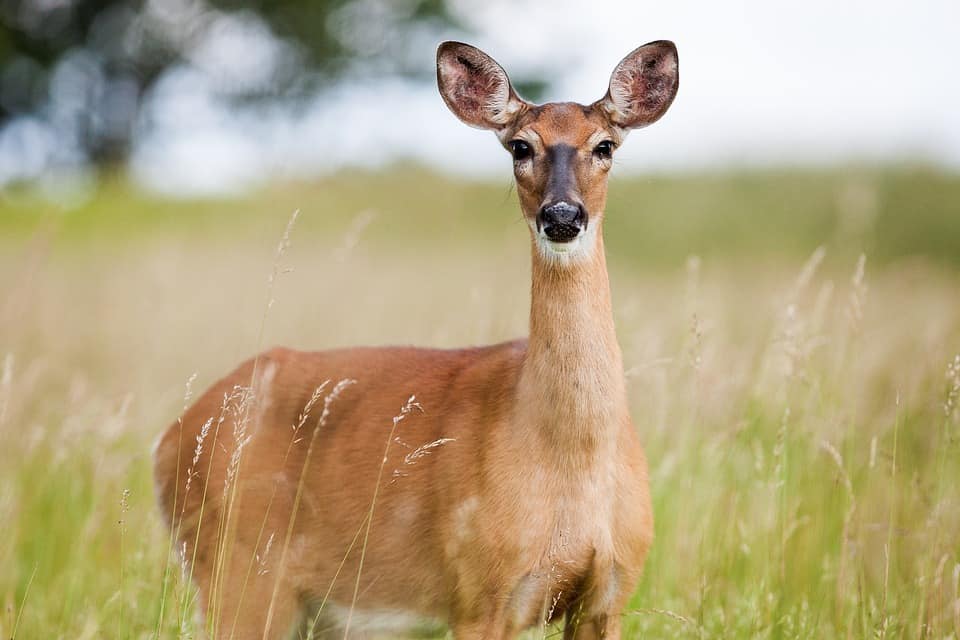You’re riding on a backcountry road. Nothing but the trees, wind, and bright blue sky to worry about, then, a thought pops into your mind – what if a deer runs out to the middle of the road?
We’ve all asked the question at some point. I certainly have. It’s not out of the ordinary too. We don’t have deer where I live but we have dogs, cats, cows, water buffalos, and pedestrians who look at both sides of the road while they’re crossing, not before.
Hitting an animal while riding
You’re probably curious about what the experience would be like and how it would feel. This has actually happened to me thrice. Two of those times I was riding in a secluded area and the other one was at an alley. The first two times I hit stray dogs and the third one, a cat.
The two dogs were fine. I hit them with the front wheel and they just sort of got ‘pushed out’ of the way. My handlebars budged a bit but I was able to maintain control. I just gripped the handlebar tight and kind of clenched up. They just got bumped out of the road both times and I was able to keep myself upright.
As for the cat, it actually ‘ran into’ my rear wheel and got caught under my bike so it, unfortunately, didn’t survive. And still, I was able to keep balance and maintain control. But, they were small and I wasn’t going too fast. It could be a whole different story if it’s someone else riding faster and hitting something bigger.

What is it like?
Unlike a car, where, if you hit a deer you could still be relatively unscathed, hitting a deer with a motorcycle might end in much greater injury. Hitting an animal while riding could be thought of as hitting a big pothole or bump on the road but worse.
If you hit a big pothole on a motorcycle, chances are it’ll cause you to lose control. A small bump or pothole wouldn’t be a problem, but a big one is a big problem. Of course, potholes and bumps don’t hit you from the side or blindside you.
Hitting a deer may cause riders to lose balance and control on their bikes. If you get hit from the side it could push you into oncoming traffic. If you hit a deer head-on, it could cause your front wheel to turn and cause you to low-side, like the video below. In a worst-case scenario, it can even get caught under your front wheel and cause you to flip over and you to get thrown over the bike.
As much as we should do our best to take care of animals and nature, accidents do happen. It’s not the rider’s fault, nor is it the animal’s. Accidents are just that, accidents. That’s why we, as riders, need to be prepared.
How can you avoid running into deer?
This doesn’t just go for deer. There are a lot more animals you need to be worried about when riding but deer are among the top of the list when it comes to the severity of the injury caused when hit. Here are a few things you might want to take note of before you start riding in an area with a lot of wildlife.
Do some research
Do you know who is rarely surprised by deer on the roads? Hunters, because they know where deer can be expected, and they watch for them. If you want to ride comfortably with peace of mind, think like a hunter. Some motorcycle safety courses even recommend riders to take hunter classes not just for deer but for other animals too.
Think ‘what if’
Being a defensive driver or rider saves lives. Never ever assume the best (e.g. there are probably no deer here, that car will probably stop in the intersection, that semi-truck driver probably sees me). Always assume ‘what if’. What if Bambi jumps out of the bushes to give my bike a big hug? Having this mindset could change your life.
Improve your skill
Always cover the front brake. Having a finger or two on the front brake to buy a second or two of braking could have a drastic effect on your chances of reducing injury. Practice emergency stops. Adopt the ‘what if’ mindset and practice emergency stops at a safe controlled environment. Attend a track day. Get expert training. When you spot a deer ahead, your front brake is a lifesaver, but only if you’re ready, willing, and able to use it right.
Look for clues
First, the obvious: Don’t ignore deer crossing signs, especially at peak times! Pay attention to roadkill; deer travel along the same paths and tend to be hit in the same places over and over. Don’t try to drag your knee around a corner at 85 km/h during deer season.
Be loud and bright
Loud pipes can sometimes save lives but not all places agree on this. At least you have your horn. If you find yourself in a secluded wooded area it could be a good idea to let out a few honks. It could drive away deer close to the road.
Bright lights are a bit risky as this sometimes causes animals to freeze in the middle of the road. But if you’re riding at night, this will increase the chances of you spotting a deer on the side of the road. Finding one or two deer would usually mean a herd is nearby so slow down.
What can you do to reduce injury?
It’s very difficult for you to be conscious of your actions if this ever happens as it happens really quick. You have less than a split second to react. Your body and mind will most likely act on instinct and impulse if this ever happens. There’s no easy way to say this, but there’s a big chance you’ll get injured if you hit an animal while riding, so what can you do if you can’t escape the inevitable?
Wear gear
This is, of course, the most important thing to do. Wearing gear could be what separates a few scratches from a few broken bones. Deer aren’t actually that heavy so the impact doesn’t really do the worst damage. It’s the crash after the impact that does the most harm. If you’re riding motorcycles, you should be wearing safety gear at all times anyway.
Watch your speed
Some people suggest that if you find yourself in deer country, you should speed up to get your butt out of there as fast as you can. That suggestion isn’t just crazy, it’s super crazy! Increasing your speed just increases how hard you’ll hit a deer and how hard you’ll hit the pavement. We all know that it’s not the speed that kills, it’s the sudden stop.
Always carry a first-aid kit
You never know what’s going to happen on the road. It could be you or your friend who would need a quick medical fix. I never ride without my first-aid kit and neither should any rider. Even if you end up never using it, there’s nothing to lose.
Follow a car
If you’re riding at night or near dusk or dawn, when deer are relatively more active, try to stay behind a car. A car’s headlight can better illuminate the road than tiny motorcycle lights. If you’re riding during the daytime, staying close to another vehicle means somebody might see you or will be able to help you if you’re ever downed by a deer.
Ride staggered
If you’re riding in a group, ride a little farther from each other when passing through an area with lots of wildlife. If one of you hits a deer, chances are the herd will be crossing the road too. You’d want to avoid having more than one rider going down.
